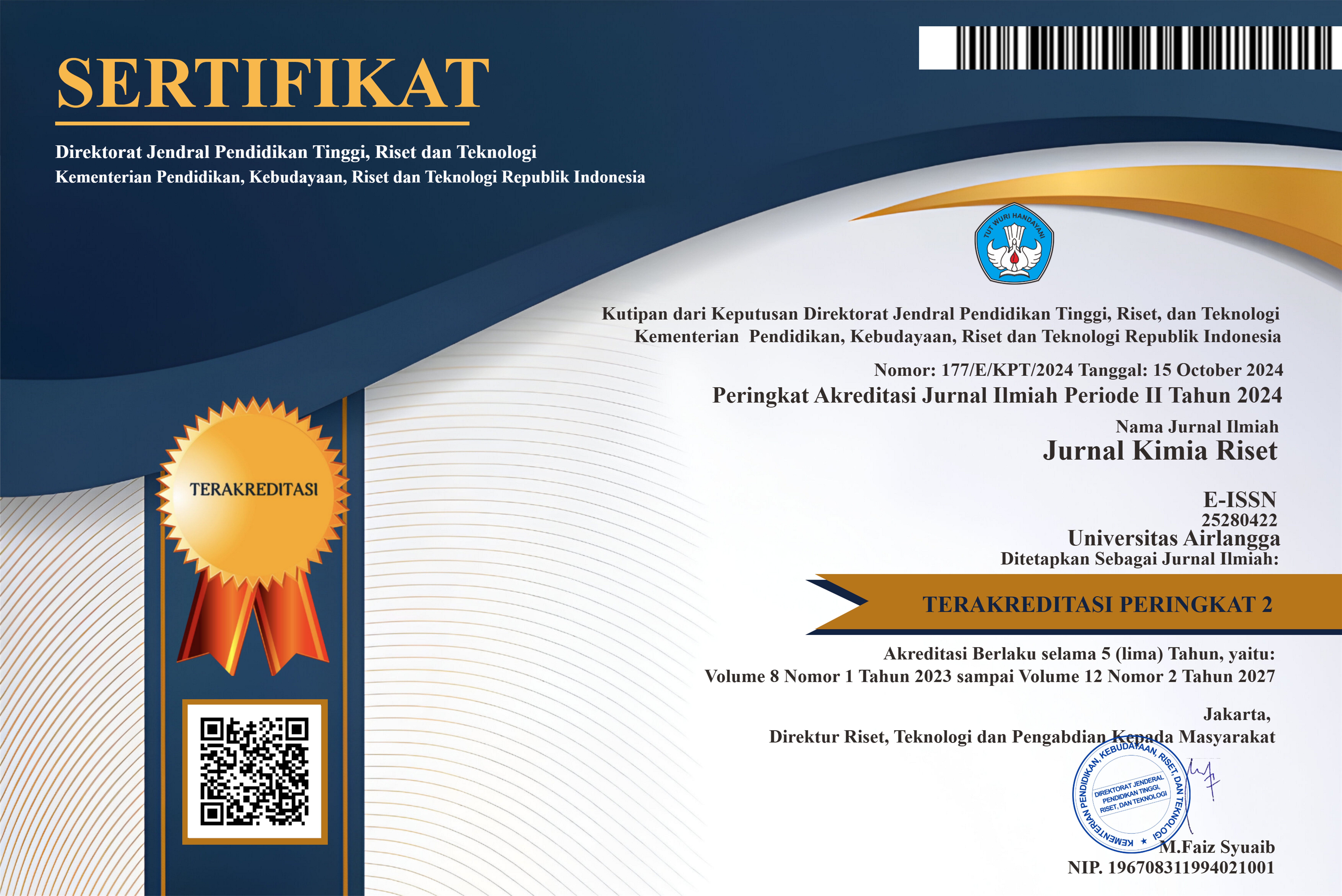Synthesis and Characterization of Carboxymethyl Cellulose from Cellulose of Empty Fruit Bunches (EFB)
Downloads
Empty fruit bunches (EFB), a substantial agricultural waste, offer great potential for value. This study aimed to use cellulose of EFB as a source of carboxymethyl cellulose (CMC) is considerable because cellulose-based waste is categorized as the most abundant waste in nature and is easy to obtain. Cellulose was then converted to the CMC process in several steps, including cellulose alkalization, and carboxymethylation. The resulting CMC was characterized to determine its degree of substitution, viscosity, and other physicochemical properties. Characterization with Fourier Transform Infrared Spectroscopy (FTIR) verified the effect of NaOH concentration on this property. The highest degree of substitution (DS=1.34) was observed in 50 % NaOH of carboxymethylation. Cellulose can be correctly extracted from EFB and converted to CMC. Based on the cellulose of the EFB characteristic, the proper amount of NaOH was found to get a high DS. CMC has considerable features for application on biodegradable polymer materials.
Adinugraha, M. P., Marseno, D. W., & Haryadi. (2005). Synthesis and characterization of sodium carboxymethylcellulose from cavendish banana pseudo stem (Musa cavendishii LAMBERT). Carbohydrate Polymers, 62(2), 164–169.
Asl, S. A., Mousavi, M., & Labbafi, M. (2017). Synthesis and characterization of carboxymethyl cellulose from sugarcane bagasse, 12 (3), 123-129.
Candido, R. G., & Gonçalves, A. R. (2016). Synthesis of cellulose acetate and carboxymethylcellulose from sugarcane straw. Carbohydrate Polymers, 152, 679–686.
Ching, Y. C., & Ng, T. S. (2014). Effect of preparation conditions on cellulose from oil palm empty fruit bunch fiber. BioResources, 9(4), 6373–6385.
Galiwango, E., Rahman, N. S. A., Al-Marzouqi, A. H., Abu-Omar, M. M., & Khaleel, A. A. (2019). Isolation and characterization of cellulose and α-cellulose from date palm biomass waste. Heliyon, 5(12), 124-128.
Gómez, F., Combariza, M., & Blanco-Tirado, C. (2017). Facile cellulose nanofibrils amidation using a ‘one-pot’ approach. Cellulose, 24, 717–730.
Haleem, N., Arshad, M., Shahid, M., & Tahir, M. A. (2014). Synthesis of carboxymethyl cellulose from waste of cotton ginning industry. Carbohydrate Polymers, 113, 249–255.
Heinze, T., & Pfeiffer, K. (1999). Studies on the synthesis and characterization of carboxymethylcellulose. Die Angewandte Makromolekulare Chemie, 266(1), 37–45.
Huang, C. M. Y., Chia, P. X., Lim, C. S. S., Nai, J. Q., Ding, D. Y., Seow, P. B Chan, E. W. C. (2017). Synthesis and characterisation of carboxymethyl cellulose from various agricultural wastes. Cellul. Chem. Technol, 51(7–8), 665–672.
Kedang, Y. I., Atmaja, L., Santoso, M., & Priyangga, A. (2023). The Effect of Phosphotungstic Acid Filled on Carboxymethyl Cellulose/Polyvinyl Alcohol Matrix as the Polymer Electrolyte Membrane. In Materials Science Forum, 1080 (1), 49–62..
Kukrety, A., Singh, R. K., Singh, P., & Ray, S. S. (2018). Comprehension on the synthesis of carboxymethylcellulose (CMC) utilizing various cellulose rich waste biomass resources. Waste and Biomass Valorization, 9, 1587–1595.
Ng, L. Y., Wong, T. J., Ng, C. Y., & Amelia, C. K. M. (2021). A review on cellulose nanocrystals production and characterization methods from Elaeis guineensis empty fruit bunches. Arabian Journal of Chemistry, 14(9), 103339.
Ngadi, N., & Lani, N. S. (2014). Extraction and characterization of cellulose from empty fruit bunch (EFB) fiber. Jurnal Teknologi, 68(5).
Palamae, S., Dechatiwongse, P., Choorit, W., Chisti, Y., & Prasertsan, P. (2017). Cellulose and hemicellulose recovery from oil palm empty fruit bunch (EFB) fibers and production of sugars from the fibers. Carbohydrate Polymers, 155, 491–497.
Paranjape, P., & Sadgir, P. (2023). Heavy metal removal using plant origin biomass and agricultural waste-derived biomass from aqueous media: a review. Water Conservation Science and Engineering, 8(1), 9.
Permana, D., Atmaja, L., Priyangga, A., Kedang, Y. I., & Santoso, M. (2024). Utilization of cellulose-based carbon nanodots in sulfonated polysulfone based membrane for direct methanol fuel cell. South African Journal of Chemical Engineering, 48, 265–275.
Pushpamalar, V., Langford, S. J., Ahmad, M., & Lim, Y. Y. (2006). Optimization of reaction conditions for preparing carboxymethyl cellulose from sago waste. Carbohydrate Polymers, 64(2), 312–318.
Rahman, M. S., Hasan, M. S., Nitai, A. S., Nam, S., Karmakar, A. K., Ahsan, M. S.,Ahmed, M. B. (2021). Recent developments of carboxymethyl cellulose. Polymers, 13(8), 1345.
Rani, M. S., Rudhziah, S., Ahmad, A., & Mohamed, N. S. (2014). Biopolymer Electrolyte Based on Derivatives of Cellulose from Kenaf Bast Fiber. Polymers, 23, 256-258.
Sophonputtanaphoca, S., Chutong, P., Cha-aim, K., & Nooeaid, P. (2019). Potential of Thai rice straw as a raw material for the synthesis of carboxymethyl cellulose. International Food Research Journal, 26, 969–978.
Vorobyova, V. I., Skiba, M. I., Shakun, A. S., & Nahirniak, S. V. (2019). Relationship between the inhibition and antioxidant properties of the plant and biomass wastes extracts-A Review. International Journal of Corrosion and Scale Inhibition, 8(2), 150–178.
Windiastuti, E., Bindar, Y., & Hasanudin, U. (2022). Identification of potential application of oil palm empty fruit bunches (EFB): a review. In IOP Conference Series: Earth and Environmental Science, 1063, 120-124).
Yeasmin, M. S., & Mondal, M. I. H. (2015). Synthesis of highly substituted carboxymethyl cellulose depending on cellulose particle size. International Journal of Biological Macromolecules, 80, 725–731.
Copyright (c) 2025 Jurnal Kimia Riset

This work is licensed under a Creative Commons Attribution-NonCommercial-ShareAlike 4.0 International License.
COPYRIGHT NOTICE
1. By submitting the article to Jurnal Kimia Riset (JKR), the author has agreed to transfer some of the copyrights to the publisher of the research chemistry journal, Universitas Airlangga, indicated in the Copyright Transfer Agreement.
2. Authors still retain significant rights to use and share their own published articles for non-commercial purposes subject to Creative Commons Attribution-NonComercial 4.0 International License
3. All publications (printed/electronic) are open access for educational purposes, research, library, and other non-commercial purposes. Besides the purposes mentioned above, the editorial board is not responsible for copyright violations.















